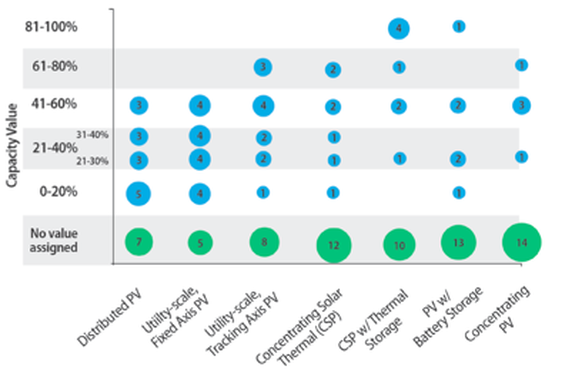 This image from NREL shows responses of utility planners interviewed about the capacity value that they assigned to solar, by technology. Numbers in circles refer to number of utility respondents. Fortunately, utility planning, as well as operations, are changing to recognize the benefits as well as costs of distributed PV. Source: J. Sterling, J. McLaren, et. al., Treatment of Solar Generation in Utility Resource Planning, National Renewable Energy Laboratory, NREL/TP-6A20-60047, October 2013.
This image from NREL shows responses of utility planners interviewed about the capacity value that they assigned to solar, by technology. Numbers in circles refer to number of utility respondents. Fortunately, utility planning, as well as operations, are changing to recognize the benefits as well as costs of distributed PV. Source: J. Sterling, J. McLaren, et. al., Treatment of Solar Generation in Utility Resource Planning, National Renewable Energy Laboratory, NREL/TP-6A20-60047, October 2013. Some years back, I spoke at a national conference about the need for utilities to grasp the potential strategic value of distributed PV (DPV). The solar industry had pushed the needle, but few utilities had even experimented with the distributed-solar value proposition. I got a little worked up, and remarked that until customers, utilities, and industry partners would work together to make solar count, DPV was little more than “solar bling.” In fact, a 2013 NREL report on the treatment of solar generation in utility resource planning confirmed that even then, most utility planners believed that customer-sited DPV was simply counted as net load than generation, and its impacts, for better or worse, were easily “lost in the noise” of load forecasting. Following suit, many distribution-system operators and others in the utility saw DPV mostly as lost load, lost revenue, and pesky engineering problem.
Today, that is changing. As distributed-solar penetrations increase, DPV is being recognized as a resource. And projects like the Community Solar Value Project are supporting the collaborative work that’s needed to assure that solar counts. We believe community solar is exactly the right place to begin, because it is, by definition, a collaboration. Utilities can guide the best possible siting, design, and specification of community solar projects, regardless of ownership structures. And they can design “companion options,” involving customer demand-response or storage, creating synergy and added value for both the utility and the customer. We find utilities are especially interested in offering companion measures to adjust the generally imperfect fit between solar and costly system peaks, and to prepare for other, looming renewables-integration problems in various time domains. Community solar might be a “desert first” strategy to sell more smart-energy vegetables. And to secure needed customer participation, utilities have to take customer interests seriously. These include interests in savings and convenience, but also in embracing community values.
Our colleague Tom Hoff of Clean Power Research recently attended a CSVP workshop and shared an easily visualized example of one way to “make solar count.” Using a single household as his example, he showed how a homeowner might be dismayed to find that putting 4.4 kW of PV on the roof does relatively little to reduce total household carbon impact. Adding an electric vehicle and increasing the size of the solar system could do much better—but if the vehicle were charged at night in a region with low wind resources, it still might draw on fossil fuel. In addition, the amount of solar needed to virtually offset the vehicle’s needs could exacerbate the so-called Duck Curve, with its steep afternoon peak and risks of seasonal over-production. The solution? Well, night-time charging, for one thing. But Tom also suggested a handful of other energy-efficiency and load management solutions, such as storage water heating and pre-cooling, which taken together would make this household nearly carbon-neutral. The CSVP team recognized much of this strategy, leading us to question whether that household's solar must be on the roof, or could it be part of a community solar project? Of course it could. And we believe that broadening the value proposition from one household to a community creates a large and diverse pool of other ways to maximize value for everyone.
That is a big vision, and we are just beginning. However, our utility partners, including the Sacramento Municipal Utility District, Public Service of New Mexico, and a half-dozen more are working with us to assemble the pieces of a new, high-value community solar model carefully and quickly. Solar is coming of age, and more and more customers are ready. They care about solar, and they care if it counts.

